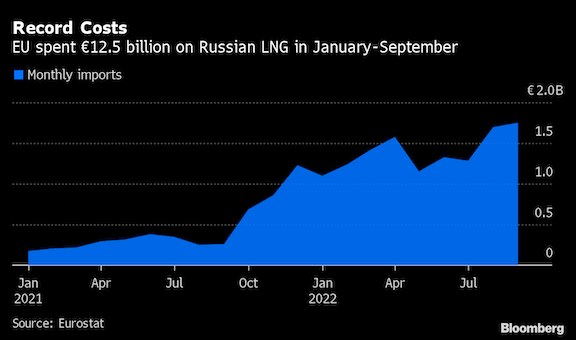The European Union has slashed its dependence on Russian energy this year, banning coal imports and readying an oil embargo too. But one product is booming, and is unlikely to face an EU boycott anytime soon.
Liquefied natural gas imports from Russia are up about 40% in a year as buyers scramble to replace dwindling piped flows. It’s a bitter pill for many across the bloc, which has slapped heavy sanctions on the Kremlin to starve it of funds fueling the war in Ukraine. The EU spent a record €12.5 billion ($13 billion) on Russian LNG from January to September -- five times more than a year earlier.
Before the invasion of Ukraine in February, piped gas from Russia had been Europe’s biggest source of the fuel. With the Kremlin’s squeeze on supply since then, the region has been forced to bring in more LNG -- from Russia and across the world -- to keep the lights on and fill up winter reserves.

“Russian LNG has to continue to flow,” said Anne-Sophie Corbeau, a researcher at Columbia University’s Center on Global Energy Policy. “We need that on the global LNG balance: it is already tight enough as it is. I think most European countries are indeed happy to turn a blind eye on this.”
Among European nations, only the UK and Baltic states have stopped buying Russian LNG. By contrast, Russian oil has been widely shunned by buyers across the region, and an EU ban is set to come into force on Dec. 5.
A complete embargo on Russian gas has never been seriously considered, given the scarcity of global supply and the potential for an even tighter market next year. Yet the EU has made efforts to find alternative supplies. In March, the bloc pledged to replace almost two-thirds of its gas imports from Russia this year, with most of the new volumes coming in the form of global LNG.
Russian gas now makes up less than 10% of the region’s supply of the fuel, down from more than a third last year, but the share of LNG in Russia’s deliveries is close to half.
Deliveries across Europe are far from even, ship-tracking data show. With Britain rejecting Russia’s LNG, cargoes have found a home elsewhere, with the country’s shipments to Belgian ports more than doubling from January to October and France’s imports up 60%.
No Embargo
“We have never announced any work on a ban on Russian gas, and that has not changed,” Eric Mamer, the European Commission’s chief spokesman, said at a briefing on Nov. 25.
Most global LNG supplies are locked into long-term contracts, with sellers often large multinationals, broadly free of government control.
France’s TotalEnergies SE, for example, has a 20% stake in Yamal LNG, Russia’s biggest production facility. While the company has halted new investments in Russia and sold some assets in the country, it has pledged to stay at Yamal to help secure Europe’s gas supply -- as long as sanctions allow. Total also owns 19% of Russia’s Novatek PJSC, which controls the project.
“Under the current conditions, there can be no ‘good’ and ‘bad’ LNG projects,” Novatek Chief Executive Officer Leonid Mikhelson said in October. The company is also adding capacity, with the giant Arctic LNG 2 development starting as soon as next year.
State energy giant Gazprom PJSC, principally a supplier of piped gas to Europe, has also started sending LNG to the region. Although its massive Sakhalin 2 project in Russia’s Far East generally ships cargoes to Asia, a new, smaller facility on Russia’s Baltic Sea coast has sent its first deliveries to Greece.
That’s not to say Russia won’t curb supplies of LNG in the future, as it’s done with piped flows. Earlier this year, Moscow barred shipments of the super-chilled fuel to a former Gazprom trading unit seized by Germany. Some buyers have also feared the government may demand ruble payments for LNG, as it did for piped gas back in the spring, but there’s no such decision so far.
Price Gains
The impact of the burgeoning LNG trade on Russia’s budget is unclear, though the government is seeking higher profit taxes from exporters of the fuel. And while Moscow has been sending less piped gas to Europe, it will have reaped gains from eye-watering market prices.
For now, it appears Europe has little option but to continue buying Russia’s liquefied gas. With consumers suffering the worst cost-of-living crisis in decades and steep fuel prices driving inflation, energy security is top of mind for governments across the region.
The gas market “is likely to remain tight until new LNG supplies become available in 2025 at the earliest,” said consultant Kate Dourian, non-resident fellow at the Arab Gulf States Institute in Washington. “It is doubtful that the EU will find consensus around tighter sanctions that would include Russian LNG.”











